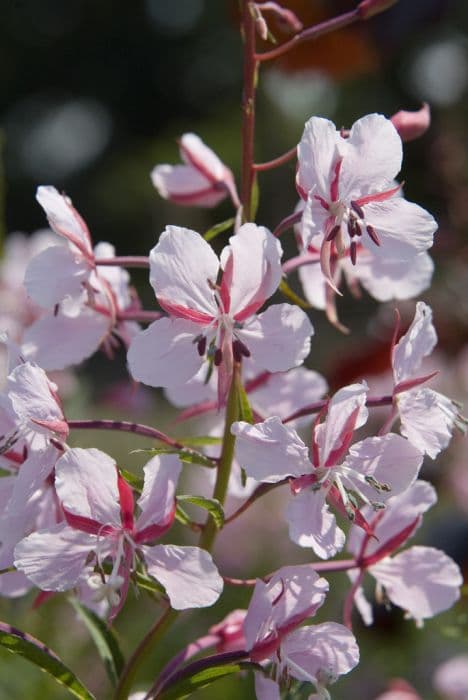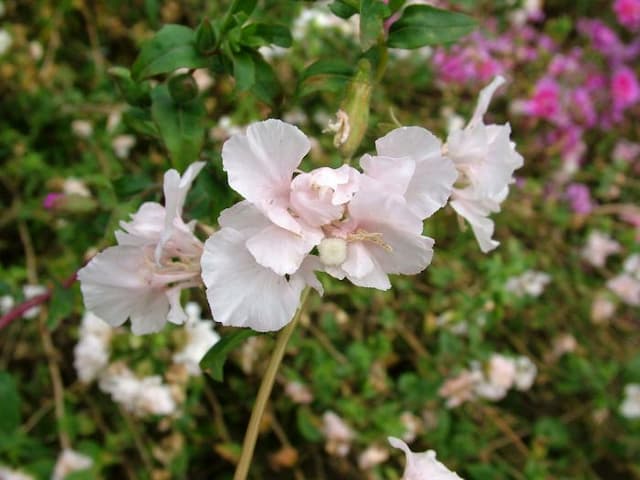Fuchsia Fuchsia 'Cascade'

ABOUT
Fuchsia 'Cascade' is a captivating plant known for its unique and vibrant appearance. The most eye-catching feature is its blossoms, which hang gracefully from the stems like delicate lanterns. These flowers are typically bi-colored, boasting a combination of pink, purple, and white hues. The outer petals often display a brighter hue, such as a vivid fuchsia pink or a deep purple, while the inner petals, usually frilly and shorter, might shine with a paler pink or a stark white. These inner petals sometimes create a striking contrast, resembling a petticoat beneath the outer skirt of the darker petals. The flowers have a teardrop shape, with the petals peeling back to reveal the inner blossoms and their long, protruding stamens that extend beyond the petals, adding an extra dimension to their beauty. These flowers are known for their graceful dangling position, emerging from the foliage in clusters that create a cascade effect, which is how the plant got its name. The foliage of Fuchsia 'Cascade' is made up of small, ovate leaves that have a slight glossy finish. The leaves are a rich green color and grow along the reddish stems, creating a lush backdrop for the showy flowers. The leaves are arranged oppositely along the branches and may have a subtle serration along their edges. Together, the foliage and flowers create a visual symphony, often making this plant an exquisite addition to hanging baskets, where their trailing habit can be admired. The overall impression is one of a bountiful, pendulous display of color and form, making Fuchsia 'Cascade' a beloved choice for gardeners looking to add a touch of elegance to their outdoor spaces.
About this plant
 Names
NamesFamily
Onagraceae
Synonyms
Cascade Fuchsia, Trailing Fuchsia
Common names
Fuchsia 'Cascade'.
 Toxicity
ToxicityTo humans
Fuchsia 'Cascade', more commonly simply known as Fuchsia, is generally considered non-toxic to humans. Therefore, ingesting parts of the Fuchsia plant typically does not result in poisoning or adverse health effects. Consequently, there are no specific symptoms of poisoning associated with this plant for humans because it is not considered poisonous.
To pets
Fuchsia is also generally recognized as non-toxic to pets, including cats and dogs. Ingestion of this plant is unlikely to cause poisoning or serious health issues. There are no well-documented toxic effects or specific symptoms of poisoning in pets from consuming any part of the Fuchsia plant.
 Characteristics
CharacteristicsLife cycle
Perennials
Foliage type
Deciduous
Color of leaves
Green
Flower color
Mixed
Height
1-2 feet (30-60 cm)
Spread
2-3 feet (60-90 cm)
Plant type
Shrub
Hardiness zones
9
Native area
Central and South America
Benefits
 General Benefits
General Benefits- Decorative Appeal: Fuchsia 'Cascade' has attractive pendant-shaped flowers in vibrant colors that add visual interest to gardens and patios.
- Hummingbird Attractor: The tubular flowers are a natural magnet for hummingbirds, providing a source of food for these birds.
- Pollinator Friendly: It supports a variety of pollinators, including bees and butterflies, which are essential for the pollination of plants.
- Shade Tolerance: It thrives in partial shade, making it an ideal choice for adding color to less sunny areas.
- Container Gardening: It’s well suited for containers, hanging baskets, and window boxes, making it adaptable to small spaces and patios.
- Extended Blooming: Fuchsia 'Cascade' offers a long flowering season from spring to fall for prolonged enjoyment.
- Versatility: Can be used in a range of garden styles, including cottage gardens, urban settings, and as underplanting for taller, sun-loving species.
 Medical Properties
Medical PropertiesThis plant is not used for medical purposes.
 Air-purifying Qualities
Air-purifying QualitiesThis plant is not specifically known for air purifying qualities.
 Other Uses
Other Uses- Fuchsia 'Cascade' can be used for creating natural dyes for fabrics with its bright-colored petals imparting subtle hues to textiles.
- The plant may be utilized in educational settings to teach students about plant growth, hybridization, and pollination due to its distinct flowering traits.
- Fuchsia flowers can serve as a source of nectar for homemade syrups or to infuse sweetness and color into cocktails and other beverages.
- Due to their bright flowers, Fuchsias like 'Cascade' can be used in color therapy practices, where colors are believed to influence mood and well-being.
- These plants can be employed in art projects, such as pressing flowers for botanical illustrations or creating natural confetti for eco-friendly celebrations.
- As a natural pest deterrent, planting Fuchsia 'Cascade' can sometimes keep certain insects, like aphids and mites, away from nearby plants.
- Fuchsia blooms can be frozen into ice cubes to create decorative elements for special events like weddings or garden parties.
- The rich color and intricate shape of Fuchsia 'Cascade' can inspire artists and designers in developing patterns and motifs for textiles and wallpaper.
- Fuchsia plants can be shaped into living sculptures or topiaries in creative garden displays, showcasing their cascading growth habit.
- Fuchsia 'Cascade' hanging baskets could act as subtle privacy barriers on apartment balconies or small patios while offering aesthetic value.
Interesting Facts
 Feng Shui
Feng ShuiThe Fuchsia is not used in Feng Shui practice.
 Zodiac Sign Compitability
Zodiac Sign CompitabilityThe Fuchsia is not used in astrology practice.
 Plant Symbolism
Plant Symbolism- Confidence and Elegance - The fuchsia's graceful droplets and vibrant colors convey a sense of confidence and elegance, reminding us of the beauty that can come with self-assurance.
- Good Taste - Fuchsia flowers, with their unique shape and striking color combinations, are symbolic of good taste and refinement, often suggesting a person who is intuitive and thoughtful.
- Ardent Love - In the language of flowers, fuchsia is often associated with love that is confiding and deep. It embodies a sense of passionate ardor and emotional depth.
- Overflowing Abundance - With the tendency to grow in profusion and a cascading habit, fuchsia symbolizes overflowing abundance, generosity, and a wealth of emotions or blessings.
- Amiability and Approachability - The humble appearance and friendly vibe of fuchsia plants often convey a sense of amicability, inviting approachability in relationships and social interactions.
 Water
WaterThe Fuchsia 'Cascade', commonly known as trailing fuchsia, needs consistent moisture and should be watered about 2 to 3 times a week or when the top inch of the soil feels dry to the touch. Use enough water to moisten the soil throughout the pot without waterlogging it, which is typically around 16 to 32 ounces depending on pot size and environmental conditions. During hot summer days, watering frequency may need to increase, while in winter it should decrease. Regular monitoring of the soil moisture will help maintain the right watering schedule for your trailing fuchsia.
 Light
LightTrailing fuchsia thrives in bright, indirect light and should be placed in a spot where it can receive morning sun and afternoon shade. Direct sunlight, especially during the hottest part of the day, can scorch the leaves and flowers. An eastern or northern exposure, or a location with filtered light, is ideal for this plant.
 Temperature
TemperatureTrailing fuchsia prefers a cool environment and thrives in temperatures between 55 and 75 degrees Fahrenheit. They can survive temporarily outside this range, but the minimum temperature should not drop below 40 degrees Fahrenheit, and the plant should not be exposed to temperatures above 80 degrees Fahrenheit for extended periods. The ideal temperature conditions ensure vibrant growth and abundant flowering.
 Pruning
PruningTrailing fuchsia benefits from regular pruning to encourage bushier growth and abundant flowering. Prune in the early spring, removing dead or weak branches, to shape the plant and promote new growth. Pinch out the tips of stems regularly throughout the growing season to encourage branching. It's best to perform a more extensive pruning after the last frost and before the onset of new growth.
 Cleaning
CleaningAs needed
 Soil
SoilFuchsias thrive in a well-draining, fertile soil with a pH of 6-7. A soil mix for Fuchsia 'Cascade' can include one part loam, one part peat, and one part sharp sand or perlite to facilitate drainage. Regularly testing soil pH and amending with lime to increase or sulfur to decrease pH can help maintain the optimal range for plant health.
 Repotting
RepottingFuchsia 'Cascade' should be repotted every two to three years or when it outgrows its pot. It's best to repot in the spring just before the new growth begins, using a slightly larger container each time to accommodate the plant's growth.
 Humidity & Misting
Humidity & MistingFuchsia 'Cascade' prefers a high humidity environment, generally between 60-70%. To maintain optimal humidity levels, especially in drier indoor air, regularly misting the plant or placing a humidifier nearby can be beneficial for its growth.
 Suitable locations
Suitable locationsIndoor
Place in bright, indirect light; keep soil moist.
Outdoor
Hang in dappled shade; shelter from strong winds.
Hardiness zone
6-9 USDA
 Life cycle
Life cycleFuchsia 'Cascade' begins its life as a seed, which germinates in a moist, warm environment to produce a tiny seedling. This seedling then develops into a young plant, exhibiting its characteristic teardrop-shaped flowers as it matures. The plant grows actively throughout the spring and summer, thriving in partial shade with abundant flowers blooming. As a perennial, it enters a period of dormancy during the colder autumn and winter months, during which growth slows down or stops, and the plant may lose its leaves. The following spring, the plant resumes growth from its root system, producing new shoots and leaves, and the cycle of flowering begins anew. Regular pruning after flowering encourages bushier growth and more prolific blooms in the next growing season.
 Propogation
PropogationPropogation time
Spring-Early Summer
The Fuchsia 'Cascade', a popular plant among gardeners for its beautiful hanging blooms, is best propagated in the spring or early summer to take advantage of the active growth season. The most popular method of propagation for this type of fuchsia is through softwood cuttings. To do this, one must select healthy, non-flowering shoots and cut a section approximately 2-4 inches (5-10 centimeters) long. The lower leaves are removed, and the cut end can be dipped in rooting hormone to encourage root development. The cutting is then placed in a well-draining potting mix, with the cut end buried about half an inch (1.3 centimeters) into the soil. Covering the potted cutting with a plastic bag or placing it in a propagator can create a humid environment conducive to rooting. The cutting should be kept in bright, indirect light and watered gently to maintain moisture without becoming waterlogged, and roots typically form within a few weeks.









